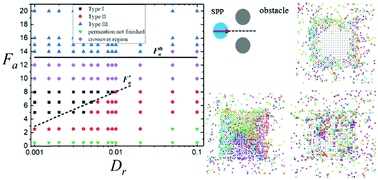Absorption of self-propelled particles into a dense porous medium†
Abstract
We study the absorption of self-propelled particles into a finite-size dense porous medium, which is mimicked by an obstacle array. We find that, depending on the competition of the propelling strength versus the repulsive barrier formed by obstacles and the contrast between the characteristic time scales of permeation and propelling persistence, the absorption process exhibits three distinct types of behavior. In Type I and II behavior, the propelling strength is not large enough to surmount the barrier, and hence particles transport in the medium by barrier-hopping dynamics. The initial permeation of particles toward the medium center is phenomenologically similar to a normal slow diffusion process. But, surprisingly, after the initial permeation process, a concentrated nucleus of particle aggregates forms and grows at the medium center in Type I, due to the long propelling persistence. Such an abnormal “nucleation” phenomenon does not appear in Type II, in which the propelling persistence is low. When the propelling strength is very high (Type III), particles transport smoothly in the medium, hence the initial slow diffusion process disappears and small particle clusters form and merge randomly in the medium. Our results provide a foundation for applications of active objects in a complex environment and also suggest the possible usage of a porous medium, for example, in the selection or sorting of active matter.



 Please wait while we load your content...
Please wait while we load your content...